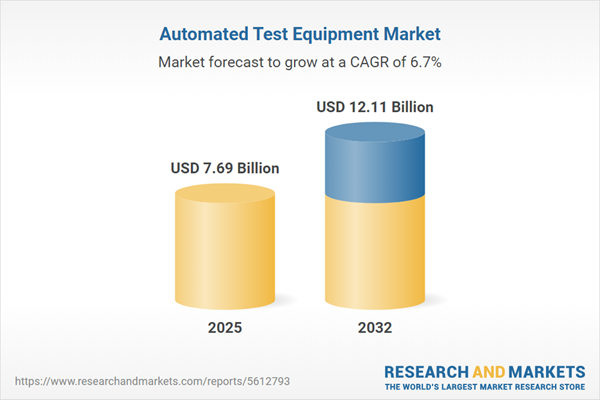Speak directly to the analyst to clarify any post sales queries you may have.
Automated test equipment (ATE) is shaping the future of quality assurance in advanced manufacturing environments. As industries demand higher precision and faster validation, the ATE market stands at the center of streamlined operations, operational agility, and innovation-driven competitiveness.
Market Snapshot: Automated Test Equipment Market Growth & Outlook
The automated test equipment market grew from USD 7.21 billion in 2024 to USD 7.69 billion in 2025. With a projected CAGR of 6.69%, it is set to reach USD 12.11 billion by 2032. Sustained momentum is driven by rising electronic system complexity and the strategic importance of high-throughput, reliable testing across global technology verticals. Semiconductor, automotive, aerospace, telecom, and electronics sectors invest in ATE to meet performance and compliance mandates while enabling innovation.
Scope & Segmentation
This report provides comprehensive coverage of market segments, technologies, and regions driving adoption of automated test equipment.
- End User Industry: Aerospace & Defense (Military, Space); Automotive (Conventional Vehicles, Electric Vehicles); Electronics (Consumer Electronics, Industrial Electronics); Semiconductor (Final Test, Wafer Test); Telecom.
- Test Technology: Functional Test (Automated Test, Semi Automated Test); In-Circuit Test (Fixture Based, Flying Probe); System Test (Burn In, Environmental).
- Product Type: Benchtop; Portable (Cart Mounted, Handheld); Rack Mounted.
- Sales Channel: Direct; Distribution (Online Distribution, Secondary Distributor).
- Geographic Coverage: Americas (North America – United States, Canada, Mexico; Latin America – Brazil, Argentina, Chile, Colombia, Peru); Europe, Middle East & Africa (Europe – United Kingdom, Germany, France, Russia, Italy, Spain, Netherlands, Sweden, Poland, Switzerland; Middle East – United Arab Emirates, Saudi Arabia, Qatar, Turkey, Israel; Africa – South Africa, Nigeria, Egypt, Kenya); Asia-Pacific (China, India, Japan, Australia, South Korea, Indonesia, Thailand, Malaysia, Singapore, Taiwan).
- Featured Companies: Advantest Corporation, Teradyne, Inc., Cohu, Inc., FormFactor, Inc., SPEA S.p.A., Chroma ATE Inc., ATS Automation Tooling Systems Inc., Seica S.p.A.
Key Takeaways
- The adoption of artificial intelligence and cloud-native orchestration is redefining test cycles, enabling autonomous platforms and real-time analytics integration into device testing.
- Companies are prioritizing modular architectures and open-platform standards, leading to faster deployment, ease of upgrades, and improved compatibility across device generations.
- Service-oriented models, such as managed test services and embedded consulting, are emerging as vital differentiators, facilitating compliance support and ongoing performance optimization.
- Regional variations are pronounced: North America emphasizes high-precision testing, Europe invests in energy efficiency and modernization, and Asia-Pacific accelerates adoption of digital twins and cloud-based solutions.
- Vertical integration and partnerships with component suppliers are increasingly essential as companies aim to localize critical processes and mitigate supply chain risks.
- Stakeholders benefit from flexible sourcing, advanced analytics, and regionalized deployments to align with dynamic end-user requirements.
Tariff Impact
Recent US trade measures have increased costs for imported test components and driven procurement teams to diversify suppliers, pursue onshoring, and renegotiate distribution contracts. These strategies bolster supply chain resilience, reduce exposure to tariff fluctuations, and support continued delivery even during shifting trade landscapes.
Research Methodology & Data Sources
The analysis utilizes primary interviews with industry executives, engineers, and supply chain managers, complemented by secondary research from industry publications, regulatory filings, and trade data. Data triangulation ensures accuracy, while subject-matter workshops refine findings and test best practices.
Why This Report Matters
- Enables senior executives to evaluate emerging technologies and testing solutions for improved operational agility.
- Guides business planning with actionable insights on risk mitigation, regional trends, and evolving customer demands.
- Supports strategic investments through detailed segmentation and benchmarking of leading companies within the automated test equipment market.
Conclusion
Automated test equipment is pivotal to operational excellence and innovation. Use these insights to strengthen technology roadmaps and sustain competitive advantage in a rapidly advancing market landscape.
Additional Product Information:
- Purchase of this report includes 1 year online access with quarterly updates.
- This report can be updated on request. Please contact our Customer Experience team using the Ask a Question widget on our website.
Table of Contents
3. Executive Summary
4. Market Overview
7. Cumulative Impact of Artificial Intelligence 2025
Companies Mentioned
The companies profiled in this Automated Test Equipment market report include:- Advantest Corporation
- Teradyne, Inc.
- Cohu, Inc.
- FormFactor, Inc.
- SPEA S.p.A.
- Chroma ATE Inc.
- ATS Automation Tooling Systems Inc.
- Seica S.p.A.
Table Information
| Report Attribute | Details |
|---|---|
| No. of Pages | 199 |
| Published | November 2025 |
| Forecast Period | 2025 - 2032 |
| Estimated Market Value ( USD | $ 7.69 Billion |
| Forecasted Market Value ( USD | $ 12.11 Billion |
| Compound Annual Growth Rate | 6.6% |
| Regions Covered | Global |
| No. of Companies Mentioned | 9 |








